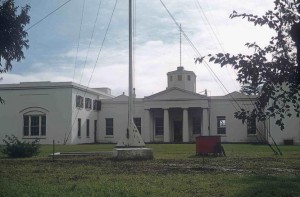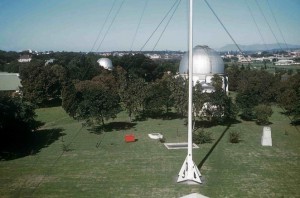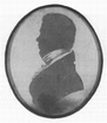|
Index:
Preparatory / To Cape Colony / Settling in / Observatory
History:
Preparatory Years
Fearon Fallows’s baptismal records give his parents as John and Rebecca Fallas. [Warner – Fallows]
His family were hand-loom weavers and as a boy, he apprenticed in the trade.
“His father was of scholarly disposition and appreciating the boy’s quick intelligence and aptitude for learning, made sure that his son had the best education that could be obtained for him. Both father and son were interested in mathematics and even before formal tuition on the youth’s behalf was secured, they made considerable progress in that subject”. [Copied from Moore, p. 44.]
He did well in his studies so “that a patron readily financed his further education at St John’s College, Cambridge. He graduated in 1813 as Third Wrangler; in the same year Sir John Herschel…was First Wrangler. (‘Wrangler is the name given in the University of Cambridge to those who have attained the first class in the public mathematical honours examination. The word itself is derived from the public disputations in which candidates for degrees were, in former times, required to exhibit their powers.’)” [Copied from Moore, p. 44.]
“Fallows obtained his M.A. degree in 1816, and after two years as a lecturer in mathematics at Corpus Christi College, he was elected a Fellow of St John’s. It was also during this period that he was ordained in the Church of England”. [Copied from Moore p. 44.]
To the Cape Colony
Fallows were sent to Cape Town by the Royal Astronomical Society (England) to start the Cape Observatory. This was to be the first Astronomical Observatory in the Southern Hemisphere (As well as the first Scientific establishment in the Southern Hemisphere).
Note: Fallows were chosen for the post at the Cape because of his skills in mathematics and astronomy. There is a common misconception concerning Fallows as mentioned by Warner: “Previous commentators on the career of Fallows have thought him unversed in matters of practical astronomy until his unexpected appointment as Astronomer Royal at the Cape. He was considered to have learned his trade in a flurry of activity, prior to sailing, but surviving letters show otherwise.” [Warner – Astronomers, p.4.] As an example is the following extract “He had no experience of practical astronomy – indeed, it is said that he had never looked through a telescope – but on his appointment to the Cape post he embarked on what is nowadays known as a crash-course, visiting observatories and similar installations and making himself familiar with the use of astronomical instruments. [Moore p. 44.] Warner goes on by showing that Fallows, whilst at Corpus Christi, grinded his own speculum metal mirror and built his own reflecting telescope / observed the solar eclipse of 18 November 1816 / hoped to set himself up with a small observatory. It is true that in preparation he spend time at Greenwich and several other amateur observatories. [Warner – Astronomers, p.5.]
On 1 January 1821 he married Mary Anne Hervey, eldest daughter of his first benefactor, the Rev. H. A. Hervey. The couple arrived in Cape Town on 12 August of that same year.” [Copied from Moore, p. 44.]
The expedition embarked on the 360 ton Soppho on 4 May 1821, consisting of Fearon and Mary Fallows, Sarah Bootle their maid, and as assistant astronomer James Frayer who was also an instrument maker (and also a great-nephew to the famous instrument maker Edward Troughton), as well as Frayers sister, Betsy. [Warner – Astronomers, p. 6.]
The voyage to the Cape Colony proceeded without any incident, except that Mary Fallows was pregnant and had a very uncomfortable journey. Things started to go wrong at their arrival. They embarked at Simon’s Town, not Cape Town. After seeing the condition of the road Fallows arranged to have his instruments shipped to Cape Town rather than by road transportation. In Cape Town he was well received by the Acting Governor, Sir Rufane Donkin, and the Colonial Secretary, Colonel Bird. However, they had no instructions to provide Fallows with any funds and he had to pay for the moving and offloading of the instruments out of his own pocket. Upon inspecting the crates “I was not mistaken in my fears for almost all the instruments had received some damage”. He could however store the crates free of charge at the Granary. [Warner – Astronomers, pp. 6 – 8.]
Settling at the Cape
Fallows initially took lodging at 22 Grave St. (now Parliament St.). According to his instructions Fallows had to set up a temporary observatory to provide time signals and to set make a catalogue of Southern stars. Sir Rufane Donkin had some wooden houses for British settlers in Port Elizabeth. (I presume the buildings were prefabricated houses for the 1820 settlers.) He kindly provided Fallows with a wooden house, which was to serve as a temporary observatory. Fallows now rented a house in 13 Kloof St., the Garden Rozenhof complex, from Mr. van Breda. The wooden house was erected as a temporary building for the transit telescope. Fallows did not stay long at this address as he apparently erected the telescope on the roof of the house, but the landlord believed he was a Peeping Tom, and threw the Fallows family out on the street. “[Van Breda] one day took offence at Mr Fallows looking into Breda’s backyard from the top of the house, Breda contending that Mr F. came to the colony for the sole purpose of looking upwards and not downwards.” He moved a final time to the property of Pieter Moller, Garden Zorg en Lust (site now occupied be the Ladies’ Christian Home), until he was able to choose a site for the permanent observatory. At Zorg en Lust he commenced a time service for ships in Table Bay. [Warner – Astronomers, pp. 7 – 10.]
On 30 November 1821 the Governor, Lord Charles Somerset, returned to the Cape to replace Acting Governor, Sir Rufane Donkin. He was a very colourful character to say the least, as well as a vindictive person. There was no love lost between Donkin and Somerset. Somerset opposed Donkins actions and ostracised his friends, including Col. Bird and Fallows. Fallows committed “a sin not to be forgiven” when he was reported to have paid his respects to Donkin as the latter embarked for England. For the rest of Somerset’s time in office the observatory project received minimal support from the authorities at the Cape. [Warner – Astronomers, p. 9.]
Establishing the Observatory
Fallows’ first task was to select a suitable site for the observatory. On explaining that he wanted to establish the Observatory on a hill, the Colonial Government, “considering that the proximity to stars was sine qua non”, offered him a site on Table Mountain so he could be closer to the stars. (Table Mountain is for a great part of the year either covered by cloud or plagued by strong winds.) After extensively scouting around quite afar in all directions Fallows settled on a hill known as Tygerberg, only to change his mind again. [Warner – Astronomers, pp.10 – 11.] The terrain that he chose was a rocky hill named Slangkop (Snake Hill) at the confluence between the Black and Liesbeek rivers. (This is the site which today houses the headquarters of the S.A.A.O.)
As to the construction there were problems. The plans were drawn up, and then redrawn. Construction was contracted out to local builders who proved to be “unsatisfactory” as well as thieves. Finding suitable building material was a constant problem and hampered by the Burmese Wars, as Burmese Teak was used in the construction. The Admiralitiy’s insistence on economising in 1827 also did not help. All these factors and more led to endless delays. For much more information on the construction process read Warner’s book Astronomers at the Royal Observatory Cape of Good Hope, pp. 11 – 25.
Fallows also had misfortunes with his staff. His assistant, James Fayrer, married the maid Sarah Bootle, both who turned out to be lazy and drunkards. He fired Fayrer and employed Reverend Patrick Scully in November 1822. Scully was the colony’s first Catholic Chaplain, a well-educated man who was better suited than Fayrer for the job. In 1824 Fallows however caught Scully in bed with a 17-year-old girl. He dismissed Scully. The British Admiralty appointed the next assistant, Captain William Ronald, who arrived at the Cape only on 19 November 1826. Ronald became ill, left for sick leave on 18 October 1830 and never returned. Now Fallows made use of his wife Mary to assist him. On 1 December 1830 Fallows hired a youth, James Robertson who assisted him until the Admiralty appointed a new assistant [Warner – Astronomers, pp.13 – 14, p.20, p.25, p.27.]
He was an Ordained Minister of the Church of England (Anglican Church). In Cape Town he was the Acting Chaplain for the Barrack Church, and he held church services in his house on the Observatory Grounds. He was also on the committee to build an Anglican Church, which became the St. Georges Church. [Warner – Astronomers, pp.13 – 14.] Note: Moore describe Fallows house was the first “Anglican Chapel” in South Africa, but I doubt the validity of the statement as Fallows stood in as Barrack Chaplain.
There was an outbreak of Scarlet Fever at the Cape in September 1830, and all the Observatory Staff contracted the fever. Fallows died of scarlet fever on 25 July 1831. He was buried in the Observatory grounds.
Mary Fallows returned on 13 September 1831 to England and presented the Admiralty with all his papers and unpublished observations. The Observations were reduced by the Astronomer Royal, Sir George Airy and published in the Memoirs of the Royal Astronomical Society in 1851. Airy thought very highly of the quality of Fallows observations and if he lived to complete his observations and publish a catalogue, he would have received much more recognition.
Career:
Fallows was not really an Astronomer, but a mathematician and an ordained Minister of the Church of England.
1813: Degree in Mathematics (3rd Wrangler) Cambridge.
1816: Masters Degree Cambridge
1817 – 1818: Lecturer in Mathematics at Corpus Christi College.
1817 – 1818: Ordained as Minister in the Church of England.
1820 (October 26): Appointed Director at Royal Cape Observatory. [Laing, p. 9.]
Arrived Cape Town 12 August 1821.
Selected site for Observatory, oversaw the construction of buildings and installation of first instruments.
Died whilst being Director.
Personal:
1822: December 19: Birth of their son named John William.
1823: January 31: Their son died. Subsequently Mary had several miscarriages.
Other personal aspects: [Warner – Astronomers, p.28.]
-Mary Fallows discovered a comet in May 1830.
-Fallows possessed a strong constitution and described as “robust and somewhat corpulent” [Warner – Astronomers, p.14.]
-As a Fellow of the Royal Society he was probably looked at as the most distinguishing scientist in the Colony.
-Fallows were an ordained minister (Anglican Church) and took his clerical duties very seriously. He made a case against the Catholic Chaplain, Patrick Scully, for having an affair. Fallows also acted as Acting Chaplain for the Barrack Chapel. He was Chairman (1829) on the committee for “Managing the Affairs of the Intended English Church during its Erection”, which became the St. Georges Church. Fallows also served on the Church of England Prayer Book and Tract Society.
-Committee member South African Infirmary Fund.
-Committee member and Trustee (1828) of the South African Library.
-Fallows and Andrew Smith led an attempt to establish a South African Literary and Philosophical Society. Lord Charles Somerset squashed this attempt and after Somerset’s departure the South African Institution was established and on 27 June 1827 Fallows was appointed the Vice President. (The S.A. Institution was the forerunner of the Royal Society of South Africa)
-Vice President of Cape of Good Hope Horticultural Society (1827 – 29)
-Member of the Wine Committee.
-Freemason at the Good Hope Lodge. |
Remaining Artifacts:
Temporary Observatory Rozenhof Complex ( Zorg – en – Lust), 18 – 28 Kloof St Gardens
Grave located in the Observatory Grounds, Cape Town.
The main building of the Observatory is known as Fallows house.
.
Pictorial:
Laing, J.D. (ed.), The Royal Observatory at the Cape of Good Hope 1820 – 1970 Sesquicentennial Offerings
.
Bibliography:
Laing, J.D. (ed.), The Royal Observatory at the Cape of Good Hope 1820 – 1970 Sesquicentennial Offerings, p
Moore, P. & Collins, P., Astronomy in Southern Africa, p. 44. (General Source)
Smits, P., A Brief History of Astronomy in Southern Africa. (Unpublished)
Warner, B., The Age of Fallows, MNASSA, Vol. 56, no 11 & 12.
Warner, B., Astronomers at the Royal Observatory Cape of Good Hope.
.
By Fallows:
Copies of Fallows’s observations were taken back to the U.K. by his wife, and published (after his death) by Sir George Airy, Astronomer Royal.
Catalogue of 273 stars, Published by Royal Society (U.K.), 1824. (This was the first formal publication of the Royal Observatory, Cape of Good Hope)Archival:
CAPE OF GOOD HOPE ROYAL OBSERVATORY PAPERS IN THE ARCHIVES OF THE ROYAL GREENWICH OBSERVATORY [JHA 9 pp.74 – 75]
-Fearon Fallows (1820-31). Original observing ledgers (Transit instrument and Meridian Circle), 1827-31.
-Official correspondence (principally with the Admiralty) 1820-31 (bound vol.). |





